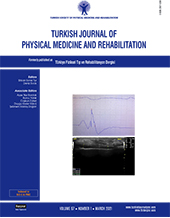The relationship between scoliosis and upper extremity functions in patients with Duchenne muscular dystrophy
2 Department of Physical Medicine and Rehabilitation, Dokuz Eylül University, Faculty of Medicine, Izmir, Turkey
3 Department of Paediatric Neurology, Health Science University, Izmir Tepecik Training and Research Hospital, Izmir, Turkey
4 Department of Neurology, Health Science University, Izmir Tepecik Training and Research Hospital, Izmir, Turkey
5 Department of Physical Medicine and Rehabilitation, Urla State Hospital, Izmir, Turkey DOI : 10.5606/tftrd.2021.4979 Objectives: The aim of this study was to investigate the relationship between scoliosis and upper extremity functions in patients with Duchenne muscular dystrophy (DMD).
Patients and methods: Between January 2018 and July 2018, a total of 55 patients (54 males, 1 female; mean age: 9.9±2.9 years; range, 6 to 15 years) who were diagnosed with DMD based on the clinical, laboratory, muscle biopsy and molecular analysis results were included in this cross-sectional study. Scoliosis was evaluated and Cobb angles were measured. Functional Ambulation Scale and Brooke and Vignos scale scores were recorded. The ABILHAND-Kids questionnaire and Nine-Hole Peg Test (9-HPT) were used to assess the upper extremity functions. Hand grip strengths were also evaluated.
Results: The median ABILHAND-Kids scores and the hand grip strength values of the patients without scoliosis were significantly higher compared to those with scoliosis (p=0.002 and p=0.004 for right hand and p=0.012 for left hand, respectively). There was no statistically significant difference in the 9-HPT scores between the patients with and without scoliosis (p>0.05). We found a negative, significant correlation between the Cobb angle and ABILHAND-Kids scores in patients with scoliosis (r=-0.503; p=0.017).
Conclusion: Our study results show a moderate relationship between scoliosis and upper extremity functions. Scoliosis may adversely affect upper extremity functions in patients with DMD.
Keywords : Duchenne muscular dystrophy, grip strength, scoliosis, upper extremity function

















